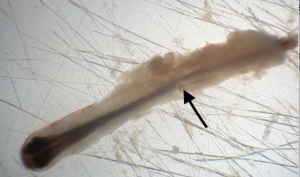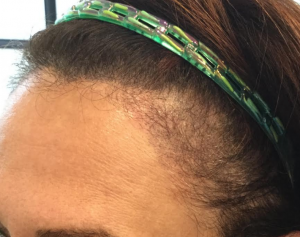Here is a photo of what appears to be a single hair for grafting, but because it can be viewed with a high powered microscope, we see that there is at least one if not two telogen hairs present (see arrow). If this graft was put in the frontal hairline, then it would look pluggy. Does your surgeon use a high powered microscope to make sure that the hair transplant is done correctly?
Cow licks (actually called widow’s peaks when they are central) are actually remnants of your juvenile hairline. Many women think that they are attractive in men and in women–over half of them actually have some for of widow’s peak present. I wrote an article on this here: https://newhair.com/wp-content/uploads/2018/11/phenotype-article-published.pdf. There are some good photos of widow’s peaks in men and women in the article.
How good does the donor area have to be to achieve that amount of coverage with the amount of hair loss he started with taken into account? Does the patient have to have a very dense donor area or would just an “average donor” area be enough?
An average donor area will work fine. A medium hair shaft or thicker hair shafts produce more fullness per graft than a fine hair this is important. It is not unusual for a fine haired person to have a second hair transplant to get more fullness
I’m trying to figure out what the half-life of fin is, in the event I end up taking 60mg one day and 140mg the next day. How much would this impact the effectiveness of fin working for me?
Finasteride has a 6-hour half-life, however, it lasts in your tissues (hair follicles) at least 7 days or more. For that reason, you don’t have to be exact on taking it, provided that you take a total of 7 mg per week. I believe that you got your numbers wrong as 60 mgs would be 60 times the dose of a standard finasteride (Propecia or 12 times the dose or a Proscare 5mg pill).
Some men find that taking finasteride, reduces their sperm count. This seems to be reversible by stopping the medication according to this authoritative source: https://academic.oup.com/jcem/article/92/5/1659/2598215
The oldest man in the world, 111-year-old Bob Weighton. A genetic freak for aging and hair. Just look at that density!
My maternal grandfather died at 102 and he had more hair than Bob Weighton because he never lost his juvenile hairline (like Bill Clinton). The other pictures is his birthday cake, but just three candles?
Everyone is different. For hair transplants, sometimes the crown grows slower than the front, sometimes it is the other way. For drugs like finasteride or minoxidil, again there is no rule.
There is a process called Apoptosis, the death of a hair cell in this case, is genetic and timed by the number of cycles it has in its lifetime. If your biologic clock dictates early death of some or all of the crown hairs and not the frontal hairs, then clearly, the drugs will work less well on the crown. The reverse is also true.
So, let’s say my maternal grandfather never went bald (His hair is white and thinning at age 75+, but had good hair most of his adulthood), but my maternal uncle is bald at 40+. My dad’s side all have decent hair. His hair is a little thin now as he is just as old as my maternal grandfather, but still enough that he still needs to get a haircut sometimes. What are my chances of going bald if my maternal uncle is balding but not my maternal grandfather? I have inherited my dad’s hairy body, but I’m not sure about testosterone sensitivity on the scalp.
There is no way to determine your risks of inheriting the balding genes.
Finasteride can reduce sperm count which may impact fertility.
Raising the eyebrows gets the forehead to wrinkle and this shows the anatomy of the muscles under the skin. The distances between the Glabella (the bridge of the nose) and the highest wrinkle on the forehead tells me a great deal when measuring the leading edge of the hairline. A normal mature hairline is usually one finger breadth distance between the highest wrinkle and the midline hairline. A picture of your entire face allows me to judge general proportions, chin to nose, nose to Glabella and Glabella to hairline. Michaelangelo in his status of David, put the proportions of these distances 1/3rd, 1/3rd, and 1/3rd however most normal people find that the distance between the chin and the tip of the nose is equal to the distance between the Glabella and the leading edge of the midline hairline.
Everyone is different in how they respond to finasteride. Some people get good quick responses while others may never get a response. Anything in between is reasonable.
Delaying hair loss depends upon (1) the types of genetic hair loss you have inherited, (2) its overall aggressiveness, (3) your ability to get good responses to drugs like minoxidil or finasteride. The drug finasteride can be very effective in delaying hairloss providing that the genes are not very aggressive.
I have seen great initial growth with finasteride in some men 18-22. It works best when the hair loss is recent. See the photo collection from Dr. Robert Bernstein’s office here: https://baldingblog.com/dr-robert-bernsteins-library-of-finasteride-results/
Page 237 of 641





